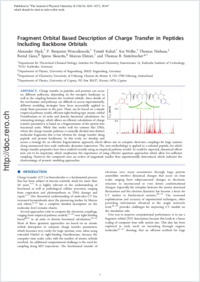Fragment orbital based description of charge transfer in peptides including backbone orbitals
- Heck, Alexander Department for Theoretical Chemical Biology, Institute for Physical Chemistry, Karlsruhe Institute of Technology, Germany
- Woiczikowski, P. Benjamin Department for Theoretical Chemical Biology, Institute for Physical Chemistry, Karlsruhe Institute of Technology, Germany
- Kubař, Tomáš Department for Theoretical Chemical Biology, Institute for Physical Chemistry, Karlsruhe Institute of Technology, Germany
- Welke, Kai Department for Theoretical Chemical Biology, Institute for Physical Chemistry, Karlsruhe Institute of Technology, Germany
- Niehaus, Thomas Department of Physics, University of Regensburg, Germany
- Giese, Bernd Department of Chemistry, University of Fribourg, Switzerland
- Skourtis, Spiros Department of Physics, University of Cyprus, Nicosia, Cyprus
- Elstner, Marcus Department for Theoretical Chemical Biology, Institute for Physical Chemistry, Karlsruhe Institute of Technology, Germany
- Steinbrecher, Thomas B. Department for Theoretical Chemical Biology, Institute for Physical Chemistry, Karlsruhe Institute of Technology, Germany
-
24.04.2014
Published in:
- The Journal of Physical Chemistry B. - 2014, vol. 118, no. 16, p. 4261–4272
English
Charge transfer in peptides and proteins can occur on different pathways, depending on the energetic landscape as well as the coupling between the involved orbitals. Since details of the mechanism and pathways are difficult to access experimentally, different modeling strategies have been successfully applied to study these processes in the past. These can be based on a simple empirical pathway model, efficient tight binding type atomic orbital Hamiltonians or ab initio and density functional calculations. An interesting strategy, which allows an efficient calculations of charge transfer parameters, is based on a fragmentation of the system into functional units. While this works well for systems like DNA, where the charge transfer pathway is naturally divided into distinct molecular fragments, this is less obvious for charge transfer along peptide and protein backbones. In this work, we develop and access a strategy for an effective fragmentation approach, which allows one to compute electronic couplings for large systems along nanosecond time scale molecular dynamics trajectories. The new methodology is applied to a solvated peptide, for which charge transfer properties have been studied recently using an empirical pathway model. As could be expected, dynamical effects turn out to be important, which emphasizes the importance of using effective quantum approaches which allow for sufficient sampling. However, the computed rates are orders of magnitude smaller than experimentally determined, which indicates the shortcomings of present modeling approaches.
- Faculty
- Faculté des sciences et de médecine
- Department
- Département de Chimie
- Language
-
- English
- Classification
- Chemistry
- License
- License undefined
- Identifiers
-
- RERO DOC 210030
- DOI 10.1021/jp408907g
- Persistent URL
- https://folia.unifr.ch/unifr/documents/303526
Statistics
Document views: 61
File downloads:
- gie_fob.pdf: 260
